
Making possible tomorrow what was promised yesterday
When he begins to talk about all that he and his team do, he cannot hide his enthusiasm. Henk van Haaster has been working at CGI for the better part of 20 years and is in charge of iAMLAB. "The abbreviation stands for infra and asset management lab," Henk explains. "Originated because we see that digitization can make the difference."
Henk has been working in the data domain for CGI since 2001, bringing together, visualizing and presenting data. "With iAMLAB we use new technologies to initiate digitalization. We all want a safer, more accessible and livable Netherlands. To create that, information must be brought together in an accessible way.
Recognize, explore and experiment
How do you create value for the end user? This is an essential question that the iAMLAB team continually asks itself. "The future can only begin if we are willing to share the information we collect, speak the same language and standardize definitions," Henk continues. "Then we need to conform to that. My team is multidisciplinary. Issues are all about recognizing, exploring and experimenting. If the outcome of a study is proven in a 'proof of value' for use cases, then it can be operationalized. This prevents disinvestment."
CGI's iAMLAB is experimenting with customers and vendors to build next-generation Asset Management environments, including technologies such as 3D, Augmented Reality (AR), Virtual Reality (VR) and Mixed Reality, sensor data for predictive maintenance and semantic databases for enriching building information models. "We like to put that in the shop window because those are the benefits we like to outline. Lidar technology may also be added to the list, creating point clouds for object recognition. Based on practice outside, you can improve data."

Integrated working in 3D based on already available data
With a Digital Twin Asset Manager, you can use VR glasses or AR to combine the physical world with administrative and real-time data. "Whether that is measuring in a meadow or inner-city area, or performing maintenance on a PLC box at a railroad crossing, the principle is that we make sure that existing data about the environment or object becomes available while you are on location. This data can provide more insights on relevant parts immediately. This also gets us thinking in 3D, rather than flat drawings. Imagine a conference table with flat 2D drawings of a bridge on it, but the attendees simply see through their phone, tablet or VR glasses a bridge in 3D, which can be viewed from all sides and where at parts all relevant info is shown. That may sound science fiction-like, but that's what we do. We work integrally in 3D, based on already available data. We visualize data in a way that makes it possible to work faster, more efficiently and with fewer errors."
Collaboration on a whole new level
iAMLAB is paving the way for working tomorrow. "Better said, the collaboration of tomorrow. As an example, I mention working underground. How nice is it when you want to open up the ground and within a collaboration platform, where you have announced your action, you get to see relevant notifications about what you are going to encounter in the underground? All based on combined data from different organizations. And you keep getting those notifications throughout the project, so you never overlook anything. This is not a utopian story, realize that the EU requires grid operators to digitize lying data for planning purposes. By deploying Computer Vision techniques, you can vectorize a significant portion of the 19 million connection lines automatically."
There is a tremendous willingness to start working together, Henk concludes. "That makes it possible to link everything that affects each other. Let iAMLAB be the booster in that process, the party that can think around, turn issues around 360 degrees and come up with solutions that really shouldn't have been invented until tomorrow."



